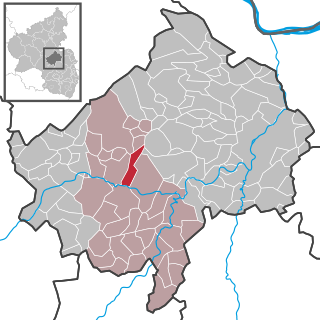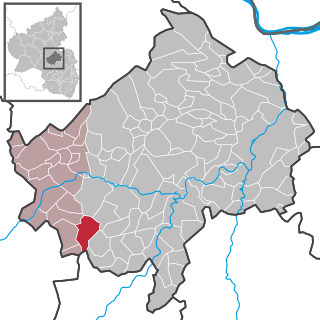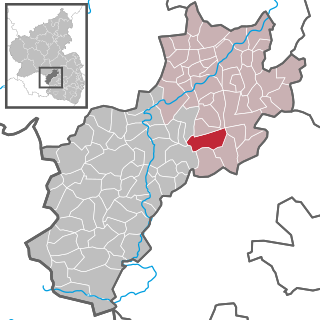
Greetsiel is a small port on the bight of Leybucht in western East Frisia, Germany, that was first documented in letters from the year 1388. Since 1972, Greetsiel has been part of the municipality of Krummhörn, which has its administrative seat in Pewsum. The nearest railway station is at Emden, about 15–20 kilometres (9.3–12.4 mi) away, and the two towns are linked by a bus service.

Nußbaum is an Ortsgemeinde – a municipality belonging to a Verbandsgemeinde, a kind of collective municipality – in the Bad Kreuznach district in Rhineland-Palatinate, Germany. It belongs to the Verbandsgemeinde of Bad Sobernheim, whose seat is in the like-named town. Nußbaum is a winegrowing village.

Norden is a town in the district of Aurich, in Lower Saxony, Germany. It is situated near the North Sea shore, in East Frisia.

Hennweiler is an Ortsgemeinde – a municipality belonging to a Verbandsgemeinde, a kind of collective municipality – in the Bad Kreuznach district in Rhineland-Palatinate, Germany. It belongs to the Verbandsgemeinde Kirner Land, whose seat is in the town of Kirn.

Monzingen is an Ortsgemeinde – a municipality belonging to a Verbandsgemeinde, a kind of collective municipality – in the Bad Kreuznach district in Rhineland-Palatinate, Germany. It belongs to the Verbandsgemeinde of Nahe-Glan, whose seat is in the like-named town. Monzingen is a more than 1,200-year-old winegrowing village and a state-recognized recreational resort (Erholungsort).

Limbach is an Ortsgemeinde – a municipality belonging to a Verbandsgemeinde, a kind of collective municipality – in the Bad Kreuznach district in Rhineland-Palatinate, Germany. It belongs to the Verbandsgemeinde Kirner Land, whose seat is in the town of Kirn.

Reiffelbach is an Ortsgemeinde – a municipality belonging to a Verbandsgemeinde, a kind of collective municipality – in the Bad Kreuznach district in Rhineland-Palatinate, Germany. It belongs to the Verbandsgemeinde of Meisenheim, whose seat is in the like-named town.

Bedesbach is an Ortsgemeinde – a municipality belonging to a Verbandsgemeinde, a kind of collective municipality – in the Kusel district in Rhineland-Palatinate, Germany. It belongs to the Verbandsgemeinde of Kusel-Altenglan, whose seat is in Kusel. Bedesbach is also a state-recognized tourist resort.

Brücken (Pfalz) is an Ortsgemeinde – a municipality belonging to a Verbandsgemeinde, a kind of collective municipality – in the Kusel district in Rhineland-Palatinate, Germany. It belongs to the Verbandsgemeinde of Oberes Glantal, whose seat is in Schönenberg-Kübelberg.

Cronenberg is an Ortsgemeinde – a municipality belonging to a Verbandsgemeinde, a kind of collective municipality – in the Kusel district in Rhineland-Palatinate, Germany. It belongs to the Verbandsgemeinde of Lauterecken-Wolfstein.

Deimberg is an Ortsgemeinde – a municipality belonging to a Verbandsgemeinde, a kind of collective municipality – in the Kusel district in Rhineland-Palatinate, Germany. It belongs to the Verbandsgemeinde Lauterecken-Wolfstein.

Dunzweiler is an Ortsgemeinde – a municipality belonging to a Verbandsgemeinde, a kind of collective municipality – in the Kusel district in Rhineland-Palatinate, Germany. It belongs to the Verbandsgemeinde of Oberes Glantal.

Eßweiler is an Ortsgemeinde – a municipality belonging to a Verbandsgemeinde, a kind of collective municipality – in the Kusel district in Rhineland-Palatinate, Germany. It belongs to the Verbandsgemeinde Lauterecken-Wolfstein.

Körborn is an Ortsgemeinde – a municipality belonging to a Verbandsgemeinde, a kind of collective municipality – in the Kusel district in Rhineland-Palatinate, Germany. It belongs to the Verbandsgemeinde of Kusel-Altenglan, whose seat is in Kusel.

Welchweiler is an Ortsgemeinde – a municipality belonging to a Verbandsgemeinde, a kind of collective municipality – in the Kusel district in Rhineland-Palatinate, Germany. It belongs to the Verbandsgemeinde of Kusel-Altenglan, whose seat is in Kusel.

Ulmet is an Ortsgemeinde – a municipality belonging to a Verbandsgemeinde, a kind of collective municipality – in the Kusel district in Rhineland-Palatinate, Germany. It belongs to the Verbandsgemeinde of Kusel-Altenglan, whose seat is in Kusel. Ulmet has long been a recognized tourism community.

Brobergen is a village in the German municipality of Kranenburg in the district of Stade, Lower Saxony. The village of 6.06 km² has 220 inhabitants.

Bargebur is an urban quarter in the east of the borough of Norden, northwestern Germany, and has a population of around 500, who inhabit an area of just 0.65 km². The houses of Bargebur have been entirely absorbed within the built-up area of Norden. In the south of the quarter, separated by the B72, which acts as a ring road around Norden here, is the Tidofelder Holz, a forest in the neighbouring municipality of Lütetsburg. Along the Fehn Canal runs the so-called Verschönerungsweg. On old maps Bargebur is also called Bergum or Westekelbur.

Westermarsch II was an independent municipality until the 1972 territorial reform in Lower Saxony and, as such, a member of the collective municipality (Samtgemeinde) of Leybucht in Lower Saxony. Today Westermarsch II is a village in the East Frisian borough of Norden with around 500 inhabitants. The village parish covers an area of 11.69 km². Curiously the main settlement of Westermarsch II is associated in public perception with the village of Norddeich, with which it has grown together. The boundary between the two runs down the middle of the road, Dörper Weg.

Tidofeld has been an autonomous part of the East Frisian borough of Norden since 1996 and has around 1,000 inhabitants ), spread over an area of just 0.47 km². Its built-up area is completely integrated with the town itself. Until 1952, Tidofeld was part of the municipality of Lütetsburg.























